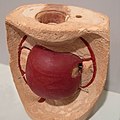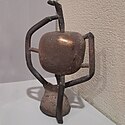Formstøbning

Statuen forestiller den egyptiske præst Kaaper.
Afstøbningen står i Den Kongelige Afstøbningssamling i København, originalen, der er af morbærfigentræ, står i Det Egyptiske Museum i Kairo.
Formstøbning, (fransk cire perdue, engelsk lost wax, tysk Feinguss), er en støbeteknik, hvor formen går tabt ved anvendelse. I antikken varierede processen fra støbning til støbning, men de enkelte trin i den benyttede proces var sædvanligvis standardiserede: Den oprindelige model erstattes først af en model af voks, og dernæst af bronze.
En voksform af en figur bliver støbt ind i gips; når gipsen er stivnet, varmes den op, således at voksen smelter og kan løbe ud af et hul. Det, der er tilbage, er et hulrum, der hvor voksformen var. Derefter hældes smeltet metal ind i gipsformens hulrum. Når metallet er stivnet og igen blevet til fast form, er støbningen færdig, og gipsen kan fjernes. Gipsforme kan kun benyttes til støbning af metaller og legeringer med relativt lav smeltetemperatur, eksempelvis bronze eller guld.
- (c) José-Manuel Benito Álvarez, CC BY-SA 2.5Trin 1
- (c) José-Manuel Benito Álvarez, CC BY-SA 2.5Trin 2
- (c) José-Manuel Benito Álvarez, CC BY-SA 2.5Trin 3
- (c) José-Manuel Benito Álvarez, CC BY-SA 2.5Trin 4
- Trin 5
Eksterne links
- "Flash animation of lost-wax casting process" Arkiveret 14. september 2010 hos Wayback Machine. James Peniston Sculpture. (engelsk)
- National Museum of Wildlife Art's Virtual Foundry Arkiveret 23. maj 2009 hos Wayback Machine (engelsk)
- "Casting a Medal" Arkiveret 21. juni 2008 hos Wayback Machine. Sculpture. Victoria and Albert Museum. (engelsk)
- Reconstructing the Bronze Age Trundholm Sun Chariot Arkiveret 11. oktober 2008 hos Wayback Machine (engelsk)
Medier brugt på denne side
(c) José-Manuel Benito Álvarez, CC BY-SA 2.5
Lost Wax Casting: original artwork of an apple from wax. Step 1 of the lost-wax bronze casting process
(c) José-Manuel Benito Álvarez, CC BY-SA 2.5
Lost Wax Casting: The sculpture of the apple, just extracted of its mold. Below is the funnel through wich the bronze was poured (upside down). Step 5 of the lost-wax bronze casting process
(c) José-Manuel Benito Álvarez, CC BY-SA 2.5
Lost Wax Casting: The hollow paraffin cast is "sprued" with a treelike structure of wax and covered in a fireproof mold of clay. The core is also filled, as seen by the hole on the right hand side. The stainless steel wires sticking out are core supports, intended to maintain the distance between core and shell once the wax has been melted out. Step 4 of the lost-wax bronze casting process
(c) José-Manuel Benito Álvarez, CC BY-SA 2.5
Lost Wax Casting: A rubber mold of the original wax model of an apple and its cast, in this case from plaster. Step 2 of the lost-wax bronze casting process
Forfatter/Opretter: palnatoke, Licens: CC BY-SA 3.0
Plaster cast of item in other museum
(c) José-Manuel Benito Álvarez, CC BY-SA 2.5
Lost Wax Casting: original artwork of an apple from paraffine. A hollow cast in paraffine, step 3 of the lost-wax bronze casting process
Forfatter/Opretter: Takkk, Licens: CC BY-SA 3.0
Liquid bronze at 1200°C is poured into the dried and empty casting mold.












